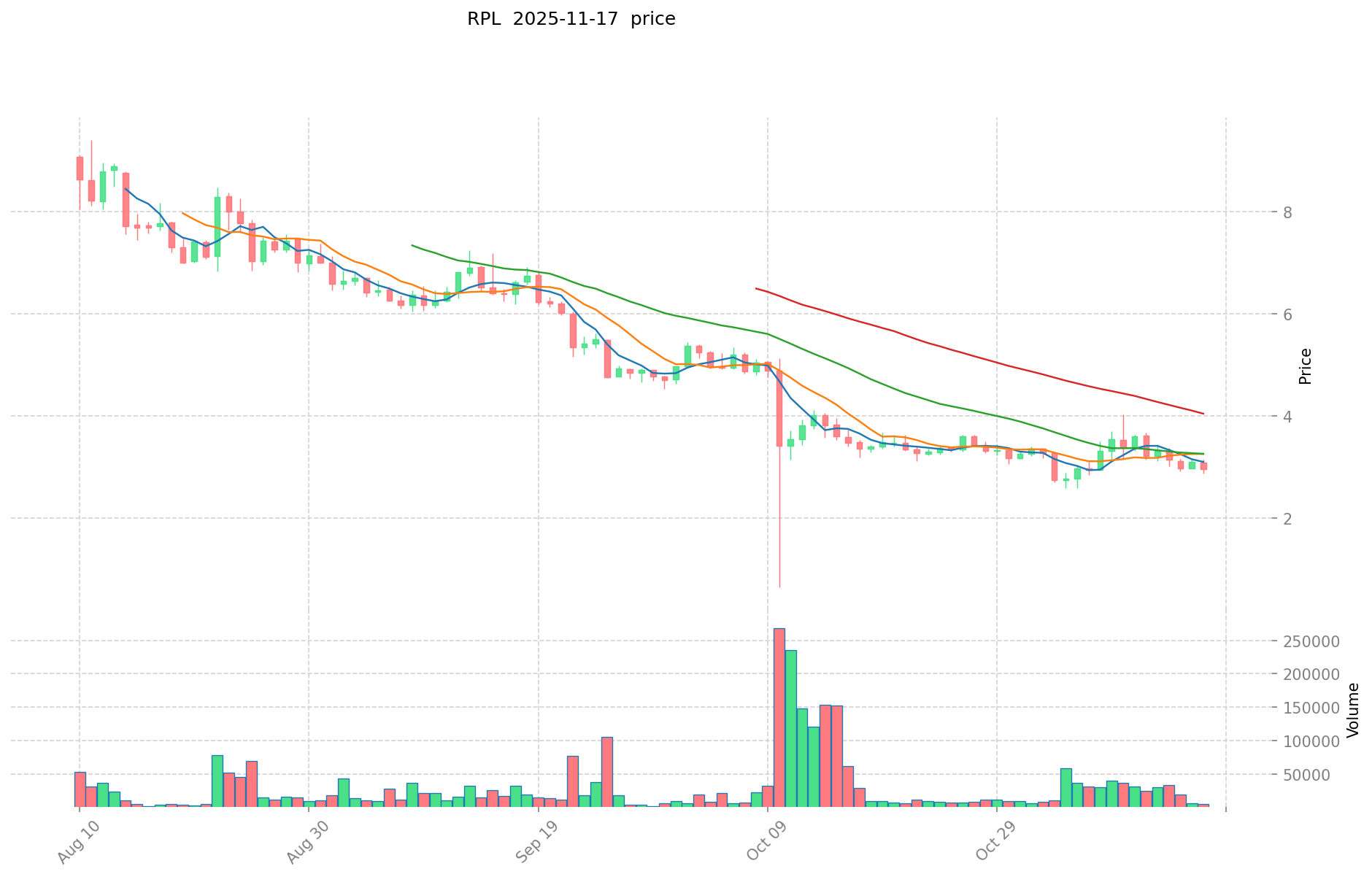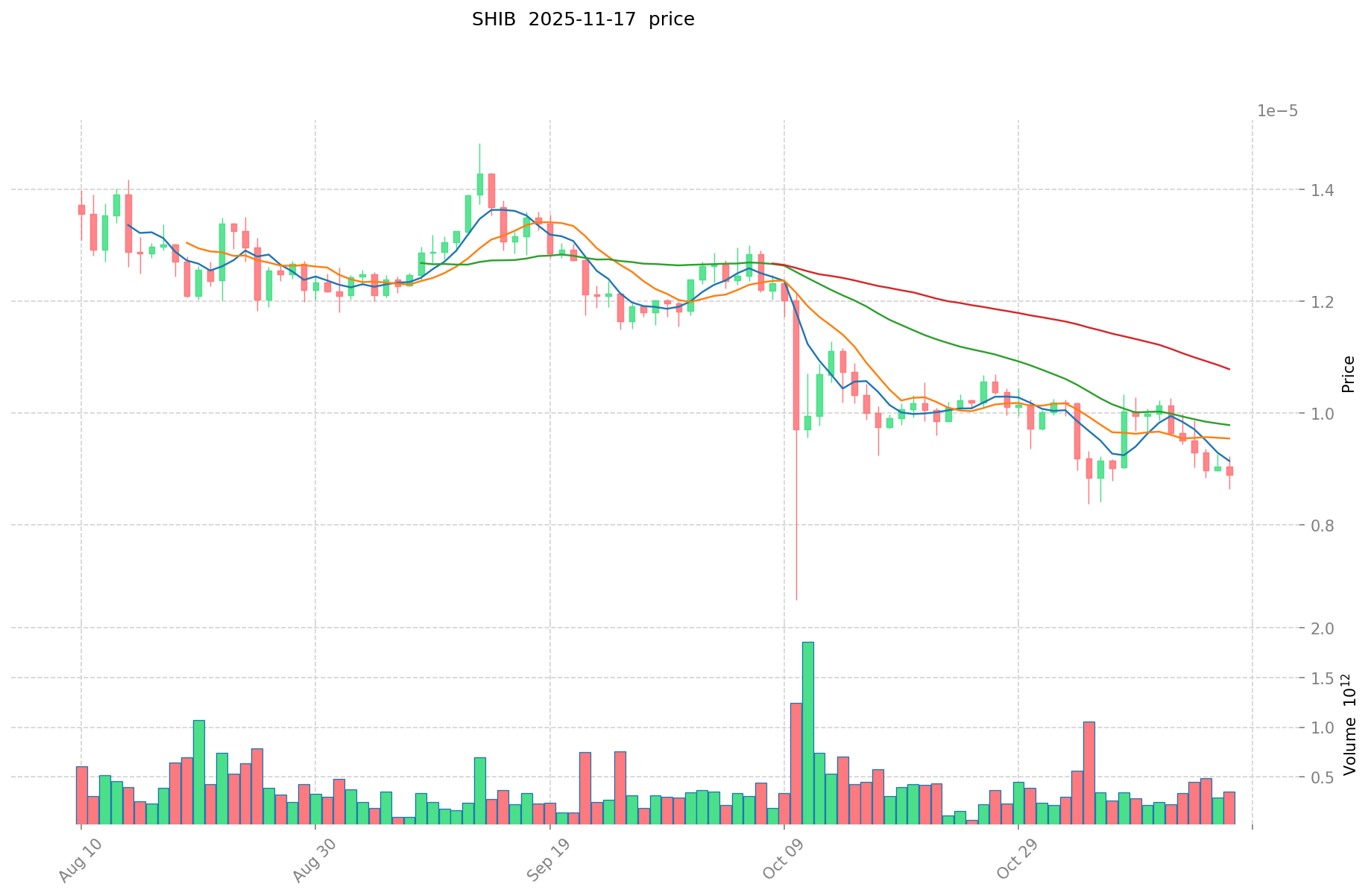RPL vs SHIB: A Comparative Analysis of Two Rising Cryptocurrencies in the DeFi Ecosystem
Introduction: Investment Comparison of RPL vs SHIB
In the cryptocurrency market, the comparison between Rocket Pool (RPL) and Shiba Inu (SHIB) has been an unavoidable topic for investors. The two not only show significant differences in market cap ranking, application scenarios, and price performance but also represent different positioning in the crypto asset space.
Rocket Pool (RPL): Since its launch, it has gained market recognition for its Ethereum PoS infrastructure service.
Shiba Inu (SHIB): Introduced as a meme token similar to Dogecoin, it has been hailed as an experiment in decentralized community building.
This article will comprehensively analyze the investment value comparison between RPL and SHIB, focusing on historical price trends, supply mechanisms, institutional adoption, technological ecosystems, and future predictions, attempting to answer the question that concerns investors the most:
"Which is the better buy right now?"
I. Price History Comparison and Current Market Status
RPL and SHIB Historical Price Trends
- 2023: RPL reached its all-time high of $61.9 on April 17, 2023.
- 2021: SHIB hit its all-time high of $0.00008616 on October 28, 2021.
- Comparative analysis: Since their respective peaks, RPL has fallen from $61.9 to $2.975, while SHIB has dropped from $0.00008616 to $0.000008953.
Current Market Situation (2025-11-17)
- RPL current price: $2.975
- SHIB current price: $0.000008953
- 24-hour trading volume: RPL $15,138.99933 vs SHIB $3,209,132.411275399
- Market Sentiment Index (Fear & Greed Index): 10 (Extreme Fear)
Click to view real-time prices:
- View RPL current price Market Price
- View SHIB current price Market Price


II. Core Factors Affecting RPL vs SHIB Investment Value
Supply Mechanism Comparison (Tokenomics)
- RPL: Fixed supply mechanism with a maximum cap of 18 million tokens, creating scarcity
- SHIB: Initial supply of 1 quadrillion tokens with partial burn mechanism through various community initiatives
- 📌 Historical Pattern: Fixed supply tokens like RPL tend to appreciate with increased adoption, while high-supply tokens like SHIB rely more on deflationary burns and community sentiment for value.
Institutional Adoption and Market Applications
- Institutional Holdings: RPL has gained traction among ETH staking providers and node operators, while SHIB has limited institutional backing despite its market capitalization
- Enterprise Adoption: RPL serves as the governance and security token for Rocket Pool's ETH staking infrastructure; SHIB is primarily used in its ecosystem including ShibaSwap
- National Policies: Both face similar regulatory scrutiny, with utility tokens like RPL potentially facing less regulatory pressure than meme coins like SHIB
Technical Development and Ecosystem Building
- RPL Technical Upgrades: Integration with Ethereum's proof-of-stake consensus mechanism and continuous improvements to the Rocket Pool protocol for decentralized ETH staking
- SHIB Technical Development: Development of Shibarium (L2 solution), ShibaSwap DEX, and expanding into NFT markets with Shiba Collectibles
- Ecosystem Comparison: RPL has a focused ecosystem centered around ETH staking infrastructure; SHIB offers broader but less specialized applications across DeFi, NFTs, and gaming through the Shiba Inu ecosystem
Macroeconomic Factors and Market Cycles
- Inflation Environment Performance: RPL may offer better inflation protection through its connection to ETH staking yields; SHIB lacks intrinsic value mechanisms to counter inflation
- Macroeconomic Monetary Policy: Both tokens show high correlation with overall crypto market trends during periods of monetary tightening and easing
- Geopolitical Factors: Neither token demonstrates significant advantages in cross-border transaction demand or response to international situations
III. 2025-2030 Price Prediction: RPL vs SHIB
Short-term Prediction (2025)
- RPL: Conservative $1.7904 - $2.984 | Optimistic $2.984 - $3.46144
- SHIB: Conservative $0.0000062755 - $0.000008965 | Optimistic $0.000008965 - $0.00001084765
Mid-term Prediction (2027)
- RPL may enter a growth phase, with prices expected between $2.954267424 and $3.717729792
- SHIB may enter a strong bull market, with prices expected between $0.000010548750176 and $0.000015312701868
- Key drivers: Institutional capital inflow, ETF, ecosystem development
Long-term Prediction (2030)
- RPL: Base scenario $3.148896387564 - $4.198528516752 | Optimistic scenario $4.198528516752 - $5.54205764211264
- SHIB: Base scenario $0.000011216011085 - $0.000017255401669 | Optimistic scenario $0.000017255401669 - $0.000019671157903
Disclaimer: This analysis is based on historical data and projections. Cryptocurrency markets are highly volatile and unpredictable. This information should not be considered as financial advice. Always conduct your own research before making investment decisions.
RPL:
| 年份 | 预测最高价 | 预测平均价格 | 预测最低价 | 涨跌幅 |
|---|---|---|---|---|
| 2025 | 3.46144 | 2.984 | 1.7904 | 0 |
| 2026 | 3.4160832 | 3.22272 | 2.094768 | 8 |
| 2027 | 3.717729792 | 3.3194016 | 2.954267424 | 11 |
| 2028 | 4.0463505504 | 3.518565696 | 1.90002547584 | 18 |
| 2029 | 4.614598910304 | 3.7824581232 | 3.177264823488 | 27 |
| 2030 | 5.54205764211264 | 4.198528516752 | 3.148896387564 | 41 |
SHIB:
| 年份 | 预测最高价 | 预测平均价格 | 预测最低价 | 涨跌幅 |
|---|---|---|---|---|
| 2025 | 0.00001084765 | 0.000008965 | 0.0000062755 | 0 |
| 2026 | 0.00001277915925 | 0.000009906325 | 0.00000842037625 | 10 |
| 2027 | 0.000015312701868 | 0.000011342742125 | 0.000010548750176 | 26 |
| 2028 | 0.000018925365235 | 0.000013327721996 | 0.000008663019297 | 48 |
| 2029 | 0.000018384259722 | 0.000016126543616 | 0.000009514660733 | 80 |
| 2030 | 0.000019671157903 | 0.000017255401669 | 0.000011216011085 | 92 |
IV. Investment Strategy Comparison: RPL vs SHIB
Long-term vs Short-term Investment Strategies
- RPL: Suitable for investors focused on Ethereum ecosystem growth and staking infrastructure
- SHIB: Suitable for short-term traders looking to capitalize on high volatility and community-driven price movements
Risk Management and Asset Allocation
- Conservative investors: RPL: 3-5% vs SHIB: 0-1%
- Aggressive investors: RPL: 8-10% vs SHIB: 2-3%
- Hedging tools: Stablecoin allocation, options, cross-token portfolios
V. Potential Risk Comparison
Market Risk
- RPL: Highly correlated with Ethereum's performance and overall crypto market trends
- SHIB: Extreme volatility and susceptibility to market sentiment and social media influence
Technical Risk
- RPL: Scalability issues, network stability dependent on Ethereum's performance
- SHIB: Smart contract vulnerabilities, reliance on Ethereum network for transactions
Regulatory Risk
- Global regulatory policies may have a more significant impact on SHIB due to its meme coin status, while RPL might face less scrutiny as a utility token
VI. Conclusion: Which Is the Better Buy?
📌 Investment Value Summary:
- RPL advantages: Fixed supply, integral role in Ethereum staking, potential for long-term growth with Ethereum adoption
- SHIB advantages: Strong community support, high liquidity, potential for rapid price movements
✅ Investment Advice:
- New investors: Consider a small allocation to RPL as part of a diversified crypto portfolio
- Experienced investors: Balance between RPL for long-term growth and SHIB for short-term trading opportunities
- Institutional investors: Focus on RPL for its utility in the Ethereum ecosystem and potential for institutional-grade staking services
⚠️ Risk Warning: The cryptocurrency market is highly volatile, and this article does not constitute investment advice. None
VII. FAQ
Q1: What are the key differences between RPL and SHIB in terms of investment potential? A: RPL is associated with Ethereum's staking infrastructure and has a fixed supply, making it potentially more suitable for long-term investment. SHIB, as a meme coin, has higher volatility and is more community-driven, potentially offering short-term trading opportunities.
Q2: How do the supply mechanisms of RPL and SHIB differ? A: RPL has a fixed maximum supply of 18 million tokens, creating scarcity. SHIB started with a supply of 1 quadrillion tokens and implements partial burn mechanisms through community initiatives.
Q3: Which token has shown better performance against inflation? A: RPL may offer better inflation protection due to its connection to ETH staking yields, while SHIB lacks intrinsic value mechanisms to counter inflation.
Q4: What are the main risks associated with investing in RPL and SHIB? A: RPL's risks include high correlation with Ethereum's performance and potential scalability issues. SHIB faces extreme volatility, susceptibility to market sentiment, and potentially higher regulatory risks due to its meme coin status.
Q5: How do institutional adoptions compare between RPL and SHIB? A: RPL has gained traction among ETH staking providers and node operators, while SHIB has limited institutional backing despite its market capitalization.
Q6: What are the projected price ranges for RPL and SHIB by 2030? A: By 2030, RPL is projected to range from $3.15 to $5.54 in optimistic scenarios, while SHIB is expected to range from $0.000011 to $0.000020.
Q7: How should investors allocate their portfolios between RPL and SHIB? A: Conservative investors might consider 3-5% allocation to RPL and 0-1% to SHIB, while aggressive investors might allocate 8-10% to RPL and 2-3% to SHIB, depending on individual risk tolerance and investment goals.
Share
Content